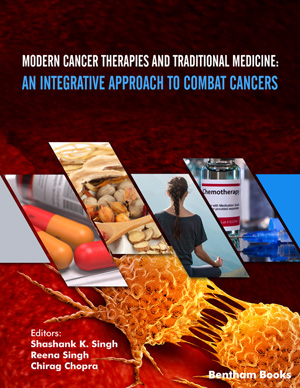
摘要
三阴性乳腺癌(TNBC)是一种缺乏靶向治疗受体的乳腺癌亚型。因此,化疗是目前系统治疗的主要选择。然而,肿瘤干细胞(CSC,一个具有干细胞特征和肿瘤启动倾向的亚群)的富集促进了化疗耐药性和肿瘤发生,导致癌症复发。此外,化疗药物的毒副作用会降低患者的幸福感。天然产物,特别是来源于植物的化合物,具有治疗TNBC和通过抑制CSC信号通路靶向CSCs的潜力。本文回顾了6种有前景化合物的文献证据,包括萝卜硫素、姜黄素、染料木素、白藜芦醇、番茄红素和表没食子儿茶素-3-没食子酸酯。这些化合物已被证明能促进TNBC细胞的细胞周期阻滞和凋亡。它们还能抑制在转移中起重要作用的上皮-间充质转化(EMT)。此外,这些天然化合物已被发现可以抑制CSCs的重要通路,如NF-κ b、PI3K/Akt/mTOR、Notch 1、Wnt/β- catenin和YAP。对这些化合物进行的临床试验显示了不同程度的有效性。还总结了对某些人类群体中通常消费的化合物的流行病学案例控制研究。虽然体内和体外数据很有潜力,但还需要进一步的基础和临床调查。很可能,天然产品与其他药物联合使用可能在改善TNBC疗效和患者预后方面有很大潜力。
关键词: 乳腺癌,三阴性乳腺癌,癌症干细胞,转移,凋亡,天然化合物。
图形摘要
[http://dx.doi.org/10.1038/modpathol.2010.200] [PMID: 21076464]
[http://dx.doi.org/10.1159/000455820] [PMID: 28611535]
[http://dx.doi.org/10.2217/pgs-2017-0117] [PMID: 29095114]
[http://dx.doi.org/10.1093/annonc/mdq279]
[http://dx.doi.org/10.1073/pnas.0530291100]
[http://dx.doi.org/10.1155/2018/5416923] [PMID: 29681949]
[http://dx.doi.org/10.1016/j.drup.2016.03.001] [PMID: 27180306]
[http://dx.doi.org/10.3390/cells5020016] [PMID: 27058560]
[PMID: 26175931]
[http://dx.doi.org/10.3390/cancers3022050] [PMID: 24212796]
[http://dx.doi.org/10.1002/1878-0261.12167] [PMID: 29316250]
[http://dx.doi.org/10.14348/molcells.2018.2242] [PMID: 29429151]
[http://dx.doi.org/10.3390/cells9081879] [PMID: 32796631]
[http://dx.doi.org/10.1186/bcr1610] [PMID: 17062128]
[http://dx.doi.org/10.18632/oncotarget.6920] [PMID: 26783961]
[http://dx.doi.org/10.4103/ctm.ctm_69_16] [PMID: 29276782]
[http://dx.doi.org/10.1016/j.ajpath.2013.06.012] [PMID: 22990110]
[http://dx.doi.org/10.3390/ijms20092272] [PMID: 31071959]
[http://dx.doi.org/10.1007/s11060-021-03702-0] [PMID: 33512631]
[http://dx.doi.org/10.21037/atm.2018.04.35] [PMID: 29911111]
[http://dx.doi.org/10.1038/84643] [PMID: 11175850]
[http://dx.doi.org/10.1023/B:CLIN.0000024761.00373.55] [PMID: 15168728]
[http://dx.doi.org/10.4103/0975-7406.155895] [PMID: 26015704]
[http://dx.doi.org/10.2174/138945006776054942] [PMID: 16515527]
[http://dx.doi.org/10.1155/2018/8324696] [PMID: 29681985]
[http://dx.doi.org/10.3390/molecules24193593] [PMID: 31590459]
[http://dx.doi.org/10.1111/j.1745-7254.2007.00679.x] [PMID: 17723168]
[http://dx.doi.org/10.1073/pnas.91.8.3147]
[http://dx.doi.org/10.1016/j.biopha.2019.109635] [PMID: 31739165]
[http://dx.doi.org/10.1158/1535-7163.MCT-06-0494] [PMID: 17339367]
[http://dx.doi.org/10.1038/s41419-018-0811-7] [PMID: 30050079]
[http://dx.doi.org/10.1038/cddis.2016.180] [PMID: 27362804]
[http://dx.doi.org/10.1038/onc.2015.293] [PMID: 26279303]
[http://dx.doi.org/10.1016/j.lfs.2018.10.034] [PMID: 30352240]
[http://dx.doi.org/10.1159/000439111] [PMID: 26372775]
[http://dx.doi.org/10.1007/s00394-013-0499-5] [PMID: 23389114]
[http://dx.doi.org/10.1016/j.bbrc.2012.09.006] [PMID: 22975350]
[PMID: 20944112]
[http://dx.doi.org/10.7150/thno.20657] [PMID: 28912888]
[http://dx.doi.org/10.1002/jcb.23386] [PMID: 21956685]
[http://dx.doi.org/10.1158/1940-6207.CAPR-18-0241] [PMID: 30679159]
[http://dx.doi.org/10.1158/1078-0432.CCR-09-2937] [PMID: 20388854]
[http://dx.doi.org/10.1016/j.breast.2012.07.013] [PMID: 22877795]
[http://dx.doi.org/10.1158/1940-6207.CAPR-15-0119] [PMID: 26511489]
[http://dx.doi.org/10.1017/S136898001500244X] [PMID: 26329135]
[http://dx.doi.org/10.1371/journal.pone.0140963] [PMID: 26524341]
[http://dx.doi.org/10.3390/foods6100092] [PMID: 29065496]
[http://dx.doi.org/10.2174/138945012804545632] [PMID: 23140290]
[http://dx.doi.org/10.1097/MCO.0000000000000598] [PMID: 31577640]
[http://dx.doi.org/10.1016/j.biopha.2016.05.037] [PMID: 27470399]
[http://dx.doi.org/10.1089/jmf.2016.3705]
[http://dx.doi.org/10.1016/j.jad.2014.06.001] [PMID: 25046624]
[http://dx.doi.org/10.3390/ijms20051033] [PMID: 30818786]
[http://dx.doi.org/10.1016/j.phymed.2009.04.008] [PMID: 19524420]
[http://dx.doi.org/10.3892/or.2012.2080] [PMID: 23076367]
[http://dx.doi.org/10.1158/1078-0432.CCR-05-1192] [PMID: 16243823]
[http://dx.doi.org/10.1111/j.1524-4741.2009.00709.x] [PMID: 19645775]
[http://dx.doi.org/10.1155/2015/878134] [PMID: 25879038]
[http://dx.doi.org/10.1016/j.cbi.2009.06.012] [PMID: 19573523]
[http://dx.doi.org/10.1097/CAD.0000000000000584] [PMID: 29356693]
[http://dx.doi.org/10.3390/cancers7030851] [PMID: 26270676]
[http://dx.doi.org/10.1186/s13045-017-0471-6] [PMID: 28476164]
[http://dx.doi.org/10.1016/j.phymed.2020.153312] [PMID: 32866906]
[http://dx.doi.org/10.1371/journal.pone.0158432] [PMID: 27348426]
[http://dx.doi.org/10.1016/j.phymed.2018.11.001] [PMID: 31005718]
[http://dx.doi.org/10.1021/jf404092f]
[http://dx.doi.org/10.4014/jmb.1801.01074] [PMID: 29642292]
[http://dx.doi.org/10.1371/journal.pone.0146553] [PMID: 26752181]
[http://dx.doi.org/10.3892/or.2016.4682] [PMID: 26985864]
[http://dx.doi.org/10.1186/s12935-014-0126-4] [PMID: 25530715]
[http://dx.doi.org/10.4196/kjpp.2013.17.4.291] [PMID: 23946688]
[http://dx.doi.org/10.3892/or.2018.6386] [PMID: 29693159]
[PMID: 25031701]
[http://dx.doi.org/10.1111/jcmm.15683] [PMID: 32725802]
[http://dx.doi.org/10.3892/mmr.2012.1103] [PMID: 23023821]
[http://dx.doi.org/10.2174/1871520615666150520093644] [PMID: 25991545]
[http://dx.doi.org/10.1002/ijc.10183] [PMID: 11857414]
[http://dx.doi.org/10.3390/ijms21239125] [PMID: 33266219]
[http://dx.doi.org/10.3389/fonc.2012.00161] [PMID: 23162792]
[http://dx.doi.org/10.3892/ijo.2019.4939] [PMID: 31894298]
[http://dx.doi.org/10.3390/molecules24142527] [PMID: 31295906]
[http://dx.doi.org/10.3892/or.2017.5593] [PMID: 28440434]
[http://dx.doi.org/10.1016/j.phymed.2020.153218] [PMID: 32335356]
[http://dx.doi.org/10.1055/s-0043-104633]
[http://dx.doi.org/10.1016/j.msec.2017.02.068] [PMID: 28415473]
[http://dx.doi.org/10.1021/mp700113r] [PMID: 17999464]
[http://dx.doi.org/10.1055/s-2006-957450] [PMID: 9619120]
[http://dx.doi.org/10.1158/1078-0432.CCR-04-0744] [PMID: 15501961]
[http://dx.doi.org/10.3390/molecules25061397] [PMID: 32204372]
[http://dx.doi.org/10.1007/978-981-13-7205-6_7]
[http://dx.doi.org/10.3390/ph12040161] [PMID: 31717764]
[http://dx.doi.org/10.18632/oncotarget.26302] [PMID: 30546830]
[http://dx.doi.org/10.1111/cas.14770] [PMID: 33316116]
[http://dx.doi.org/10.3390/molecules25194499] [PMID: 33008036]
[http://dx.doi.org/10.1186/s12906-019-2685-3] [PMID: 31638975]
[http://dx.doi.org/10.3945/an.114.008052] [PMID: 26178025]
[http://dx.doi.org/10.1016/j.bbamcr.2007.03.021] [PMID: 17490757]
[http://dx.doi.org/10.3892/ijmm.2012.990] [PMID: 22580499]
[http://dx.doi.org/10.1016/j.tiv.2008.08.001] [PMID: 18761399]
[http://dx.doi.org/10.1038/sj.onc.1206583] [PMID: 12879015]
[http://dx.doi.org/10.3892/ijo.2016.3351] [PMID: 26794366]
[http://dx.doi.org/10.1128/MCB.25.8.3364-3387.2005] [PMID: 15798220]
[http://dx.doi.org/10.1016/j.nutres.2011.01.011] [PMID: 21419318]
[http://dx.doi.org/10.3892/ijo.13.2.391] [PMID: 9664138]
[PMID: 9809990]
[http://dx.doi.org/10.5483/BMBRep.2006.39.4.448] [PMID: 16889690]
[http://dx.doi.org/10.1007/s10565-008-9054-1] [PMID: 18224451]
[http://dx.doi.org/10.1038/onc.2017.274] [PMID: 28783172]
[http://dx.doi.org/10.3892/ijo.2016.3327] [PMID: 26783066]
[http://dx.doi.org/10.3892/ijo.15.3.525] [PMID: 10427135]
[http://dx.doi.org/10.3892/ijo.26.4.1101] [PMID: 15754008]
[PMID: 9673352]
[http://dx.doi.org/10.3945/ajcn.2008.27361] [PMID: 19403632]
[http://dx.doi.org/10.1007/s10552-006-0062-2] [PMID: 17111256]
[http://dx.doi.org/10.1093/carcin/23.9.1491] [PMID: 12189192]
[http://dx.doi.org/10.1158/1055-9965.EPI-08-0405] [PMID: 19318430]
[http://dx.doi.org/10.1158/1940-6207.CAPR-11-0251] [PMID: 22307566]
[http://dx.doi.org/10.1097/00008469-200304000-00011] [PMID: 12671541]
[http://dx.doi.org/10.1093/jn/134.11.3089] [PMID: 15514280]
[http://dx.doi.org/10.1210/jc.84.11.4017] [PMID: 10566643]
[http://dx.doi.org/10.1007/BF03192335] [PMID: 12587954]
[http://dx.doi.org/10.2174/187152012803833107] [PMID: 22583407]
[http://dx.doi.org/10.1093/jn/129.2.399] [PMID: 10024618]
[http://dx.doi.org/10.1016/j.bbagen.2003.12.008]
[http://dx.doi.org/10.4161/cbt.11.10.15184] [PMID: 21389782]
[PMID: 30210672]
[http://dx.doi.org/10.1097/MCO.0b013e3282f0cef2] [PMID: 18089954]
[http://dx.doi.org/10.1016/j.semcancer.2015.11.001] [PMID: 26774195]
[http://dx.doi.org/10.1016/j.jsbmb.2019.03.001] [PMID: 30851384]
[http://dx.doi.org/10.3390/molecules24061131] [PMID: 30901941]
[http://dx.doi.org/10.1002/iub.1749] [PMID: 29637742]
[http://dx.doi.org/10.3892/ijo.2018.4512] [PMID: 30066852]
[http://dx.doi.org/10.3109/10715762.2012.671940] [PMID: 22571807]
[http://dx.doi.org/10.1002/ijc.20856] [PMID: 15688415]
[http://dx.doi.org/10.1038/emm.2016.151] [PMID: 28232662]
[http://dx.doi.org/10.1016/j.rvsc.2020.07.017] [PMID: 32745729]
[http://dx.doi.org/10.1016/j.biocel.2019.05.020] [PMID: 31173924]
[http://dx.doi.org/10.18632/oncotarget.25631] [PMID: 30018739]
[http://dx.doi.org/10.1097/01.cej.0000228413.06471.4c] [PMID: 17554206]
[http://dx.doi.org/10.1016/j.canlet.2006.08.013] [PMID: 16996206]
[http://dx.doi.org/10.1096/fj.03-0292fje] [PMID: 14563682]
[http://dx.doi.org/10.1093/oxfordjournals.bmb.a011629] [PMID: 9374036]
[http://dx.doi.org/10.1080/15216540600871118] [PMID: 16916783]
[http://dx.doi.org/10.1002/mnfr.201801239] [PMID: 30690879]
[http://dx.doi.org/10.3892/etm.2015.2895] [PMID: 26889234]
[http://dx.doi.org/10.1006/bbrc.2000.2750] [PMID: 10872829]
[http://dx.doi.org/10.1016/j.phrs.2012.08.001] [PMID: 22906730]
[http://dx.doi.org/10.1155/2015/837042]
[http://dx.doi.org/10.2174/1389557519666190128093840] [PMID: 30686253]
[http://dx.doi.org/10.3892/or.2019.7122] [PMID: 31002359]
[http://dx.doi.org/10.3892/ijo.2017.4058]
[http://dx.doi.org/10.1039/C9FO00580C] [PMID: 31120074]
[http://dx.doi.org/10.1177/153537020222701013]
[http://dx.doi.org/10.1007/s10549-006-9405-7] [PMID: 17051425]
[http://dx.doi.org/10.1146/annurev.food.102308.124120] [PMID: 22129335]
[http://dx.doi.org/10.1007/s13277-016-4798-3] [PMID: 26779636]
[http://dx.doi.org/10.1111/cas.12349] [PMID: 24397737]
[PMID: 24596385]
[http://dx.doi.org/10.2217/14622416.7.5.663] [PMID: 16886892]
[http://dx.doi.org/10.1002/em.20363] [PMID: 18181168]
[http://dx.doi.org/10.1080/01635581.2011.606955] [PMID: 21958026]
[http://dx.doi.org/10.3390/nu4111679] [PMID: 23201840]
[http://dx.doi.org/10.1155/2017/5615647] [PMID: 28884125]
[http://dx.doi.org/10.1007/s00432-017-2515-2] [PMID: 28942499]
[http://dx.doi.org/10.1074/jbc.M513378200] [PMID: 16495219]
[http://dx.doi.org/10.3892/ol.2017.6108] [PMID: 28693189]
[http://dx.doi.org/10.1097/CAD.0b013e32833a4385] [PMID: 20527725]
[http://dx.doi.org/10.3390/nu12041042] [PMID: 32290071]
[http://dx.doi.org/10.1186/1471-2407-13-421] [PMID: 24044575]
[http://dx.doi.org/10.1016/j.bmc.2012.03.002] [PMID: 22459208]
[http://dx.doi.org/10.1007/s10549-007-9678-5] [PMID: 17902053]
[PMID: 26254344]
[http://dx.doi.org/10.3390/molecules24162899] [PMID: 31404982]
[http://dx.doi.org/10.1007/s00432-013-1376-6] [PMID: 23354842]
[http://dx.doi.org/10.1371/journal.pone.0073464] [PMID: 24039951]
[http://dx.doi.org/10.1093/jn/132.8.2307] [PMID: 12163680]
[http://dx.doi.org/10.1038/84635] [PMID: 11175849]
[http://dx.doi.org/10.18632/oncotarget.1932] [PMID: 24811362]
[http://dx.doi.org/10.1158/1940-6207.CAPR-17-0187] [PMID: 28904061]
[http://dx.doi.org/10.1055/s-0032-1315129] [PMID: 25258465]
[http://dx.doi.org/10.2174/156652412798889063] [PMID: 22280355]
[http://dx.doi.org/10.1002/ijc.11259] [PMID: 12845655]
[http://dx.doi.org/10.1016/j.canep.2015.11.013] [PMID: 26680603]
[http://dx.doi.org/10.1016/j.chemphyslip.2019.04.005] [PMID: 30965023]
[http://dx.doi.org/10.1016/j.chemphyslip.2016.05.006] [PMID: 27234272]
[http://dx.doi.org/10.1016/j.ijpharm.2020.119449] [PMID: 32464231]
[http://dx.doi.org/10.1002/ptr.6154] [PMID: 30009577]
[http://dx.doi.org/10.3390/molecules24061027] [PMID: 30875891]
[http://dx.doi.org/10.1158/0008-5472.CAN-06-4699] [PMID: 17483343]
[http://dx.doi.org/10.1016/j.biocel.2015.07.009] [PMID: 26212257]
[http://dx.doi.org/10.1007/s11101-019-09628-w]
























